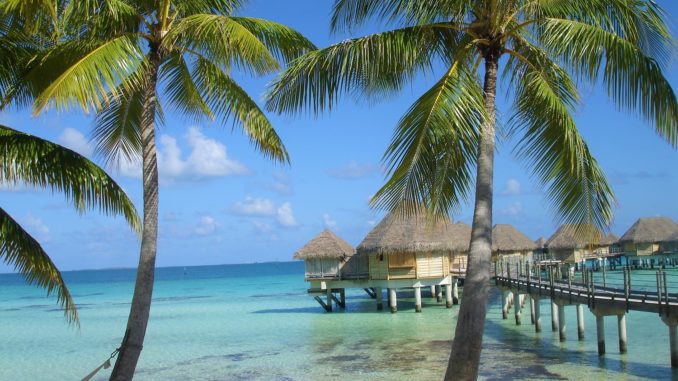
Adventures in Paradise – Exploring French Polynesia
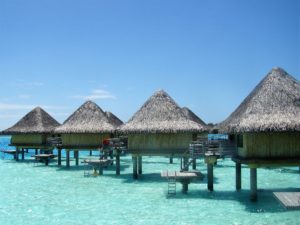
It’s amazing how the catchphrase from a 1970’s soap TV advertisement has made it into the vernacular. Who could forget the rich couple and their cuter-than-cute blond kid (who’s playing with a live duck or perhaps it’s a swan), sitting in personal matching bathtubs aboard a Concorde jet? She fancies a certain island paradise – “Tahiti Looks Nice” – she smiles, and he, momentarily glancing up from his copy of the Australian Financial Review, picks up the gold-plated phone, calls Simon the pilot and asks him to nose the Concorde towards the fabled isles. And being a health-and-safety conscious family, the trio buckles up their spa bath-fitted seat belts, including the mini-soap sized seat belt fitted to the cake of luxurious Cussons Imperial Leather.
My research tells me that the advertisers rebooted the ad a few years ago and made another, this time with the couple standing in their own separate groovy shower stalls, dousing themselves with Cussons Imperial FoamBurst shower gel – just for the Millenials, I guess. It doesn’t have the cache of the original ad, but hey — it’s nice to know Simon is still employed.
I digress. Tahiti is nice – in fact, it’s absolutely gorgeous.
Most people use the name Tahiti as a kind of shorthand for the collection of 118 islands (volcanic high islands and coral cays) stretching for some 2000 km across the South Pacific Ocean, between the Equator and the Tropic of Capricorn. The correct name for this island nation is French Polynesia and it is divided into five archipelagos. The islands were colonised by France in 1880 and today French Polynesia is officially known as an ‘overseas collectivity’ and has semi-autonomous status.
Tahiti itself is the largest island and it contains the capital, Papeete, and the airport. It belongs to the Society archipelago; the other four archipelagos are the Tuamotus off to the north-east; the Marquesas (the final resting place of artist Paul Gauguin) located further to the north of the Tuamotus; the Australs (also called the Tubuai islands) in the south; and way off in the south-east are the Gambier Islands. Many of these 118 islands are uninhabited, and those inhabited islands way off to the north and south of Tahiti are rarely visited by tourists other than the super adventurous, while sometimes an expedition ship will call in.
On my four visits to French Polynesia, I’ve been lucky enough to explore some of the Society Islands group and a couple of the low-lying coral cays in the Tuamotus. My transport varied on each island. I caught local buses, known as Le Truck in Papeete (however I believe this rustic mode of transport doesn’t exist anymore and has been replaced by your average bus), hired a car on three islands, rented a bicycle in Rangiroa, Jet-skied around Bora Bora and hopped aboard a sturdy 4WD vehicle to explore the dense jungle interior of Bora Bora to check out the WWII cannon.
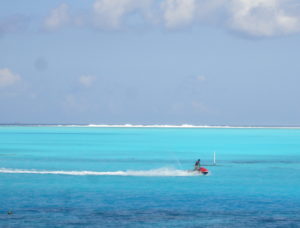
I discovered there’s a lot more to these isles than the postcard images of white sandy beaches lined with coconut palms, although they are pretty special too.My travels included research for the first, and only, edition of the Fodor’s Guide to Tahiti and French Polynesia. An American guidebook, favoured by your classic middle-American tourist with some cash to splash, it covered the main haunts and some of the more far-flung islands.
I’ve also taken a cruise on the elegant all-white ship, Paul Gauguin, which cruises the Society Islands on seven-day jaunts and a few times a year ventures to the Tuamotu group and sometimes visits Fiji. The 332-passenger ship is owned by the Pacific Beachcomber hotel group, which also owns the InterContinental hotels in Tahiti, Moorea and Bora Bora and the Maitai hotels in Huahine and Rangiroa. http://www.pgcruises.com
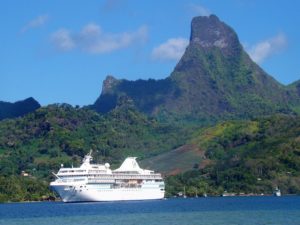
Marlon Brando and Tahiti
Pacific Beachcomber is run by CEO Richard Bailey, an American who has lived in French Polynesia for some 30 years. He was a friend of the late actor Marlon Brando who famously bought an island called Tetiaroa (53 km from Tahiti itself) in 1966 after falling in love with the breathtaking scenery as well as his co-star in the 1961 film Mutiny on the Bounty, the 19-year-old Tahitian-Chinese girl, Tarita Teriipaia. The couple married in 1962 but the marriage was not to last. The Brando family, however, still owns Tetiaroa (which is made up of six tiny coral islets). In 2014 Richard Bailey and the Brando family opened the a super-swanky environmentally-sound resort and naturally called it The Brando. Rates are said to be between US$4500 a night for a one-bedroom villa in the low season to upwards of US$17,000 a night if you book at three bedroom villa in the high season. I’ve not had the pleasure of bunking down in those digs but I have flown over Tetiaroa on my way to island of Tikehau. A rather slight brush with fame I admit, but it was fun to look down from the plane and see a few dots of gold and green in an otherwise sea of brilliant blue! http://www.thebrando.com
Here’s a brief overview of some of French Polynesian’s charms.
Tahiti
Most travellers don’t linger too long in Tahiti, the largest island. They fly in and usually the next day fly out to somewhere else like Bora Bora. But it’s worth spending a few days in Tahiti, which is, in fact, two islands – Tahiti Nui (big Tahiti) and Tahiti Iti (little Tahiti). They are joined by an isthmus at a town called Taravao. The coastal road around Tahiti Nui is 114 km, so it’s a pretty easy drive once you get used to driving on the other side of the road and work out the flow of the roundabouts (which I admit I never quite mastered!) I hired a car at the airport and ventured out onto that main coastal road on a dark, rainy night and drove some 20 km east to my hotel, the Raddison Resort. It was a challenge; the rain certainly didn’t help, while locals kept honking me as I stopped at roundabouts trying to work out just what to do. The next day, however, it fined up and off I went on my circular journey.
Along the way I discovered the blowhole (Arahoho), Point Venus Lighthouse, a couple of waterfalls and lava tubes (just a little hike inland from the coastal road), Paul Gauguin’s small museum (to be honest it isn’t that interesting as there are few original pieces on show), a grotto at Maraa and several black sand surfing beaches. If time allows, and you can actually work out the roundabout at Taravao, then head over to Tahiti Iti and drive to the very end of the southern road to the famous surfing spot of Teahupoo where the Billabong surfing classic takes place.
There are several big-name resorts about 10 to 20 km from Papeete itself (InterContinental and Hilton to name a few). If you see a public bus motoring along the main coast road, you might want to hop aboard. However, be warned public transport isn’t very reliable and I’ve read the buses stop at around 4 pm. (Hiring a car is the best option).
Everyone visits the market (Le Marche) to check out the fresh food and tropical fruits downstairs and the handicrafts on sale upstairs. Sometimes there’s an island band playing. Everything is expensive in Tahiti, so the market is probably the best bet for a reasonably-priced souvenir. You can pick up bottles of famous Monoi oil (said to do wonders for your hair and skin); some of the oil is infused with the essence of the Tiare flower, the lovely white flower which is the country’s emblem.
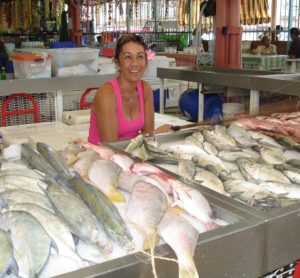
Moorea
This is the sister island to Tahiti and just 19km away, across the Sea of the Moon. There are seven-minute flights, but seriously take the 30-minute ferry ride and watch Tahiti recede into the distance and Moorea and its majestic cloud-swathed mountains, come into view. Pick up some pineapples at the wharf and then head off to explore the island. The coastal road is only 63 km long and it’s an easier drive than Tahiti. One of the joys of self-driving is the opportunity to stop for a swim along the way, take photos of the lovely churches with their (often red) steeples and call into small restaurants. Moorea has the greatest diversity of accommodation in French Polynesia. Many Tahiti residents have holiday houses there. You’ll find mum-and-dad owned pensions, small hotels, resorts (of course) and even some backpacker and camping sites. Hire a boat (as some friends and I did once) and explore the lagoon and dive in. You can go horse-riding if you please, visiting ancient temple sites (known as marae), but make sure you take a drive or a tour up to the Belvedere lookout for fantastic views of Cook’s (on the right) and Opunohu Bay on the left. Most of the Polynesian scenes from the 1984 movie Bounty (which starred Mel Gibson as Fletcher Christian) were filmed in Opunohu Bay. Many hardy types like to hike into the island’s rugged island and others get a kick out of climbing the mountain peaks. If you just want to kick back, then book a few nights at the Sofitel or Hilton resorts and soak in the views of those lofty peaks from your deck chair.
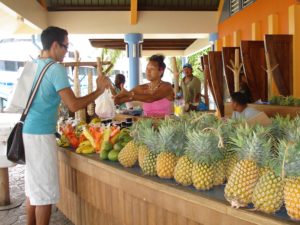
Most of the main resorts are clustered around the two main bays, but if you’d like a sleepy experience then head to the west of the island, around the town of Haapiti where you’ll find a couple of small pensions. I stayed at the family-run Residence Linavera, which I notice has changed hands and is now called Linavera Beach Resort. Thankfully it still gets great reviews.
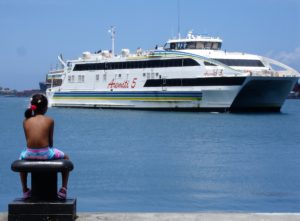
Bora Bora
Novelist James A Michener called Bora Bora the most beautiful island in the world. He knew a thing or two about the region – he was a lieutenant in the U.S. Navy and assigned to the South Pacific as a naval historian. Later he wrote Tales of the South Pacific, which was adapted into the Broadway musical South Pacific. Who could ever forget, “I wanna wash that man right outa my hair”! Make no mistake it is breathtaking even from the plane as you make your landing onto one of the small motu, or islands, which ring the sensational lagoon. The experts say the lagoon’s waters are not only blue but embody seven shades of blue. They like to call it a sea-bow (a play on rainbow and a little bit corny). It’s seriously beautiful and has to be seen to be believed.
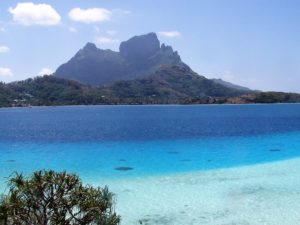
The lagoon encircles the main island, which is dominated by a peak known as Mount Otemanu. Shrouded by clouds the volcanic mountain has a foreboding beauty. When I first saw it in 2003 I was reminded of one of those scary volcanoes in an old “Road to” movie; I’m not sure which movie it was, but one of those fabulous old movies with Bing Crosby, Bob Hope and Dorothy Lamour, made in the 1940s to 60s and which held me captivated as a child. I think the mountain in the movie was set to explode and the two stars were desperate to get off, even though Bing had probably fallen in love with one of the beautiful local gals or was it Dorothy?
In something of a parallel, U.S. troops were stationed in Bora Bora during WWII and they didn’t want to leave either; they too had fallen in love with the ladies. From all accounts the marines didn’t see much military action during the war – they did install four sets of two cannon on each of the four points on the island. There are apparently only seven cannon left, according to some reports, while others say the eight cannon are still in situ.
I took a 4WD into the interior about 10 years ago with tour operator Tupuna Mountain Safari. It was a rough trip up and over steep trails, but hugely enjoyable. I’ll always remember we adults were gripping the side of the vehicle and screaming with delight as we bumped along, but the one teenage boy on the trip never once looked up from this portable video game! We checked out one set of cannon, however, I can’t tell you whether it was on the north, south, east or west side of the island. The views across the lagoon were fantastic and we saw jet-skiers zipping past below. The next day I was aboard a jet-ski, riding pillion with my driver Warren (surely not his real name) and what a blast that was!
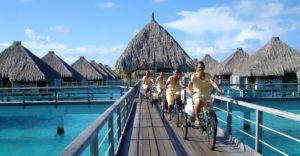
I was fortunate enough to stay in two very groovy resorts – the fabulous St Regis (where Nicole Kidman and Keith Urban honeymooned in 2007) and the InterContinental Bora Bora Resort Thalasso Spa. The latter is known for its innovative spa treatments, which involve using products from deep sea, and also for its gorgeous little wedding chapel, where the pathway that connects the entrance to the altar is actually a glass ‘bridge’ – the brides can see the fish swimming below as they walk the short distance to meet their groom.
There’s a lot to love about Bora Bora but it is very expensive. Everyone wants to stay in an overwater bungalow, especially the newlyweds. I say “go ahead and book that overwater, end of the pontoon hotel room” but do expect to pay lots and lots more than if you’d booked a beachside bungalow. I suggest a happy compromise might one or two nights in an overwater bungalow to watch Tahiti Television (that’s the cute local name for the hole in the floor through which you can see fish and other lagoon critters) and then move to a beach or garden bungalow. You’ll save a motza, which you can later spend on car hire, a lagoon snorkelling trip or a very expensive meal at the sought-after Villa Mahana restaurant. http://www.villamahana.com
Bora Bora is the romantics’ island but for the rest of us who may be there alone or with their best mates, there are plenty of things to do. Number one on the list is getting into that gorgeous lagoon – swim in it, snorkel and dive in it, zip around it on a Jet-ski, swim with those manta rays and sharks (all harmless) or just wade in the shallows. But have fun!
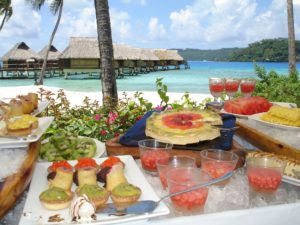
This is part one of my continuing French Polynesia series, so stay tuned for more — I’ll talk about Huahine, Tahaa, Raiatea, Rangiroa and Tikehau and all the ways you can get to French Polynesia and get around the islands.
Tomorrow February 26 I head off to French Polynesia again. I’ll be taking a Viking Ocean Cruises trip from Tahiti to Auckland. I’ll be keen to see how Tahiti & Bora Bora have changed since my last visit some seven years ago. http://www.vikingcruises.com
For more information on the Pacific Beachcomber group check out the website: http://www.pacificbeachcomber.com/
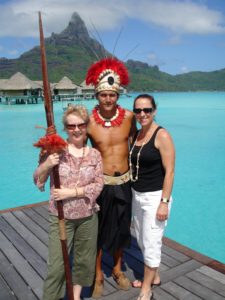
For more information on French Polynesia, check out the website: https://tahititourisme.com.au/en-au/
To read a story of mine on attending church in French Polynesia, check out this site: http://www.traveller.com.au/a-spiritual-venture-in-rangiroa-2jorc
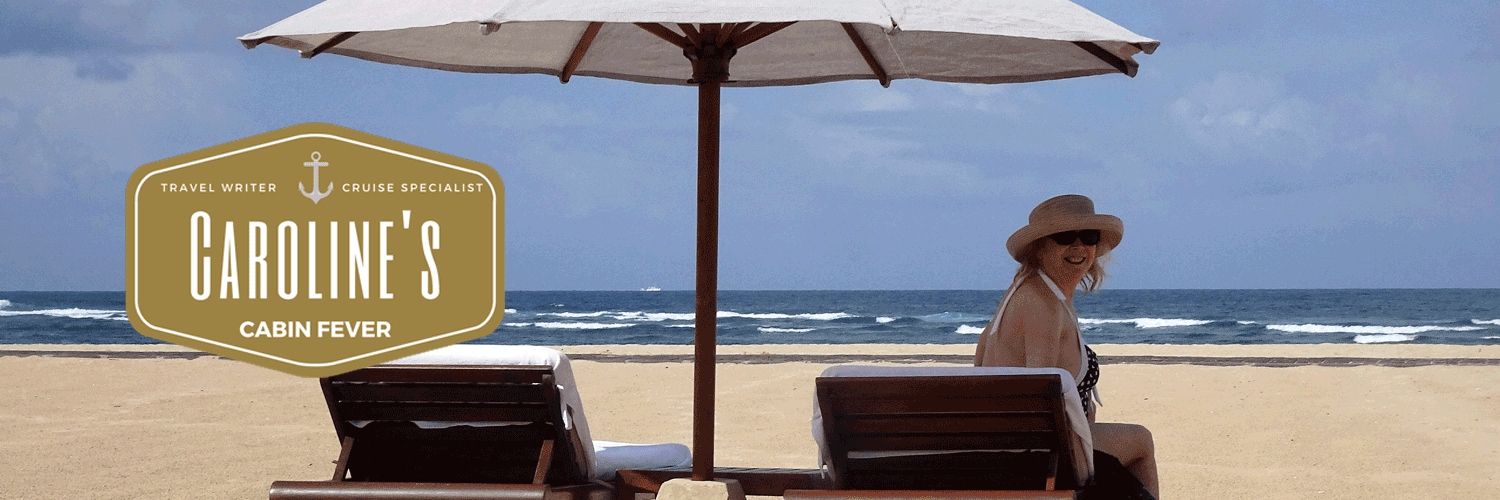

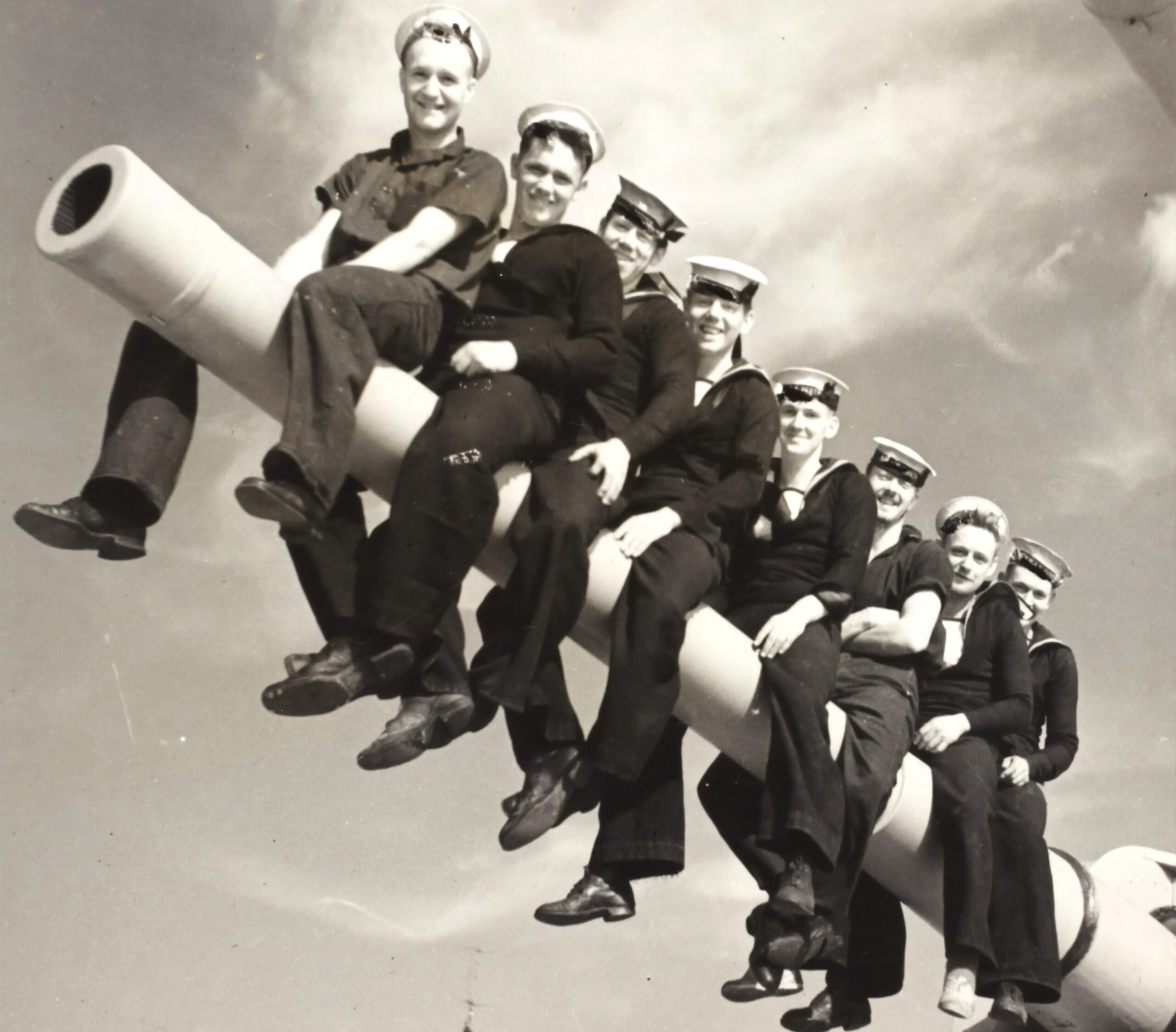

Loved the story & photos of Tahiti especially Bora Bora & it is just as it looks in travel brochures a real paradise. One visit is definitely not enough. Look forward to reading more.
Thanks Lesley. Yes, Bora Bora outdoes any of the travel brochures. The colour, or I should say colours, of the lagoon outdoes anything you’ve ever seen. Thanks for reading and responding to my blog. Cheers, Caroline